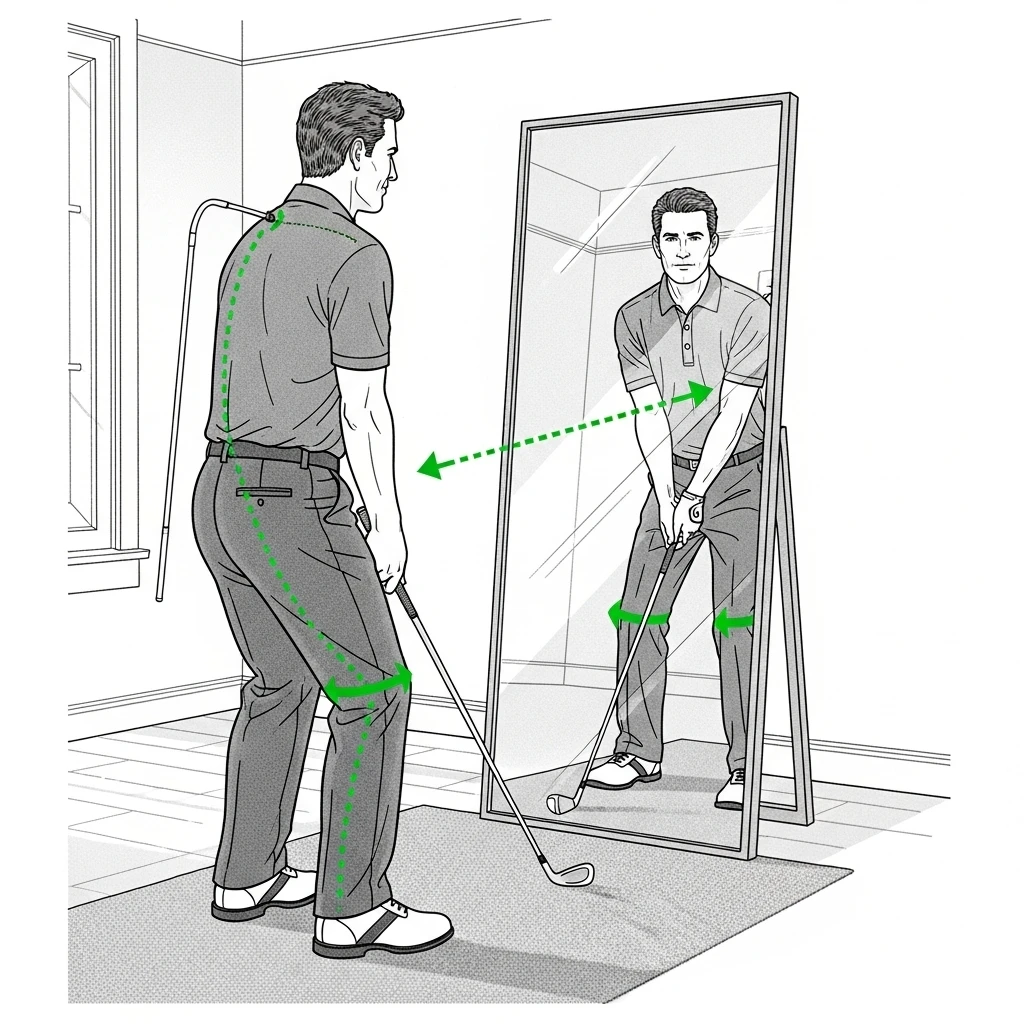As golfers, we all dream of hitting that perfect, smooth swing that sends the ball flying straight down the fairway. But let’s face it getting to the course or the driving range every day just isn’t realistic for most of us. That’s why learning how to improve your golf swing at home is one of the smartest things you can do for your game.
Whether you’re a beginner working on the basics, or a more experienced player looking to fine-tune your technique, practicing at home is a fantastic way to build good habits, develop consistency, and strengthen your confidence without spending hours on the road or paying for expensive lessons every week.
In this guide, I’ll walk you through why at-home practice is so effective, how to set up your space, and the best drills and tips you can use to see real improvement in your swing.
Table of Content
- 1. Can you really improve your swing at home?
- 2. How long should I practice at home each day?
- Why Practice at Home?
- Take a Look at Your Swing First
- Setting Up Your Home Practice Area
- Drills to Improve Golf Swing at Home
- Keep Track of Your Progress
- Watch Out for These Common Mistakes
- Recommended Training Aids
- Conclusion
Why Practice at Home?
Many golfers assume that improvement only happens on the course. But the truth is, most of the work happens behind the scenes in garages, backyards, and even living rooms. Practicing at home gives you the chance to really focus on your technique without distractions.
One of the biggest benefits is consistency. When you practice your swing regularly, even for just 20–30 minutes a day, you build muscle memory. That means when you do get out on the course, your body already knows what to do. Practicing at home also saves you time and money, and it lets you focus purely on mechanics, not on how far the ball goes or what score you’re shooting.
Even professional golfers spend countless hours practicing at home. If it works for them, it can absolutely work for you too.
Take a Look at Your Swing First
Before you start practicing drills, it’s a good idea to understand what your swing currently looks like. This will help you identify the areas that need the most attention.
One simple way to do this is to record yourself. Use a smartphone or a tripod to take a video of your swing from two angles one from directly behind you (down-the-line) and one from the side (face-on). Watch the video and compare it to professional swings online. Look for things like your balance, your takeaway, your follow-through, and your impact position.
Another helpful tool is a mirror. Set one up in your practice area so you can watch your setup and your swing in real time. Seeing what you’re doing wrong is the first step to fixing it.
Setting Up Your Home Practice Area
You don’t need a lot of space or fancy equipment to improve your golf swing at home. Even a small corner of your garage, backyard, or living room can work just fine. The key is to have enough room to swing freely without hitting anything.
Here are some basic things you’ll want to set up:
- Golf mat: Protects your floor and gives you a realistic feel underfoot.
- Practice net: Catches your balls if you want to hit real ones, and makes indoor practice safer.
- Mirror: Helps you check your posture, alignment, and swing positions.
- Alignment sticks: Great for working on setup and aim.
- Impact bag: Useful for feeling a solid strike at impact.
- Weighted club or resistance bands: Helps build strength and flexibility.
If you’re practicing indoors, consider using foam or plastic practice balls. They’re safe, quiet, and let you swing without worry.
Drills to Improve Golf Swing at Home
Now let’s talk about the drills you can do every day to see real improvement in your swing. Each of these focuses on a different part of your technique, and together they’ll help you develop a smooth, consistent, and powerful swing.
1. Posture and Grip Drill
Your setup is the foundation of a good swing. Stand in front of a mirror and get into your address position. Make sure your feet are shoulder-width apart, your knees slightly bent, your spine straight, and you’re bending from the hips, not your waist. Practice getting into this position until it feels natural.
Check your grip too it should feel comfortable and allow your wrists to hinge properly. Many golfers grip too tightly or set their hands incorrectly. A proper grip can make a world of difference.

2. Slow Motion Swing Drill
This is one of the most effective ways to improve your golf swing at home. Without a ball, take your club and swing as slowly as possible. Pay attention to every phase: the takeaway, the backswing, the transition, the downswing, the impact, and the follow-through.
Doing it in slow motion helps your body memorize the correct sequence and positions. Over time, you’ll find your full-speed swing becoming more consistent and balanced.

3. Impact Position Drill
One of the most important moments in your swing is the instant of impact. You want to make solid contact, with your hands slightly ahead of the ball and your weight shifting forward.
Use an impact bag (or even a couch cushion) and practice stopping your swing right at the impact position. This will help you feel what a proper strike should feel like, and it’s a great way to build confidence in your ball striking.
4. Tempo and Rhythm Drill
Good rhythm is often overlooked, but it’s critical for a smooth swing. Use a metronome app or simply count in your head: “one” on the backswing, “two” at the top, and “three” on the downswing through impact. This keeps your swing in sync and prevents you from rushing.
5. Mirror Drill
Set up in front of your mirror and watch yourself as you swing. Pause at the top and at impact to check your positions. Over time, you’ll start to see improvement and it’s very satisfying to watch your swing take shape.
6. Strength and Flexibility Drills
Finally, don’t forget that your body is just as important as your technique. Spend a few minutes each day on stretches and exercises that improve your flexibility, balance, and core strength. Exercises like planks, hip stretches, and yoga poses are fantastic for golfers. The more mobile and strong you are, the easier it is to rotate properly and generate power.
Keep Track of Your Progress
Improvement doesn’t happen overnight, but it will happen if you stay consistent. Keep a simple log of your practice sessions, noting what drills you did and how they felt. Record yourself once a week so you can compare your swing over time.
If you’re unsure whether you’re improving, consider sending your swing videos to an instructor for feedback. Many coaches now offer virtual lessons that are surprisingly affordable.
Watch Out for These Common Mistakes
It’s easy to develop bad habits if you’re not careful. Here are a few things to avoid when working on your swing at home:
- Practicing the wrong mechanics without feedback.
- Swinging too fast or too hard before you’ve mastered the basics.
- Skipping warm-ups or neglecting flexibility work.
- Focusing too much on power instead of control.
You have to remember quality is always more important than quantity.
Recommended Training Aids
Over the years, I’ve tested a lot of golf gadgets and training aids to improve golf swings at home. Here are a few I recommend to help you improve your golf swing at home:
- Golf Impact Bag – great for practicing solid contact.
- SKLZ Gold Flex Trainer – perfect for building rhythm and flexibility.
- Orange Whip Trainer – helps with balance and tempo.
- Golf Putting Mat – improves your short game indoors.
These tools aren’t essential, but they do make practice more effective and fun.
FAQs
1. Can you really improve your swing at home?
Absolutely. Many players see huge improvements from practicing drills and mechanics regularly at home.
2. How long should I practice at home each day?
Even just 20–30 minutes of focused, high-quality practice is enough to see results.
3. What’s the biggest mistake beginners make?
Practicing incorrect mechanics over and over without checking their form or getting feedback.
Conclusion
Improving your swing doesn’t require a driving range, an expensive simulator, or hours and hours of free time. With just a little space, a few basic tools, and a consistent plan, you can absolutely improve your golf swing at home and start playing better golf where it really counts: on the course.
Stay patient, keep practicing the right way, and don’t hesitate to ask questions if you get stuck. If you stay consistent, you’ll see real progress and you’ll feel more confident every time you tee up.
If you have any questions or want more personalized advice, feel free to leave a comment or reach out. I’m always happy to help fellow golfers improve their game.


